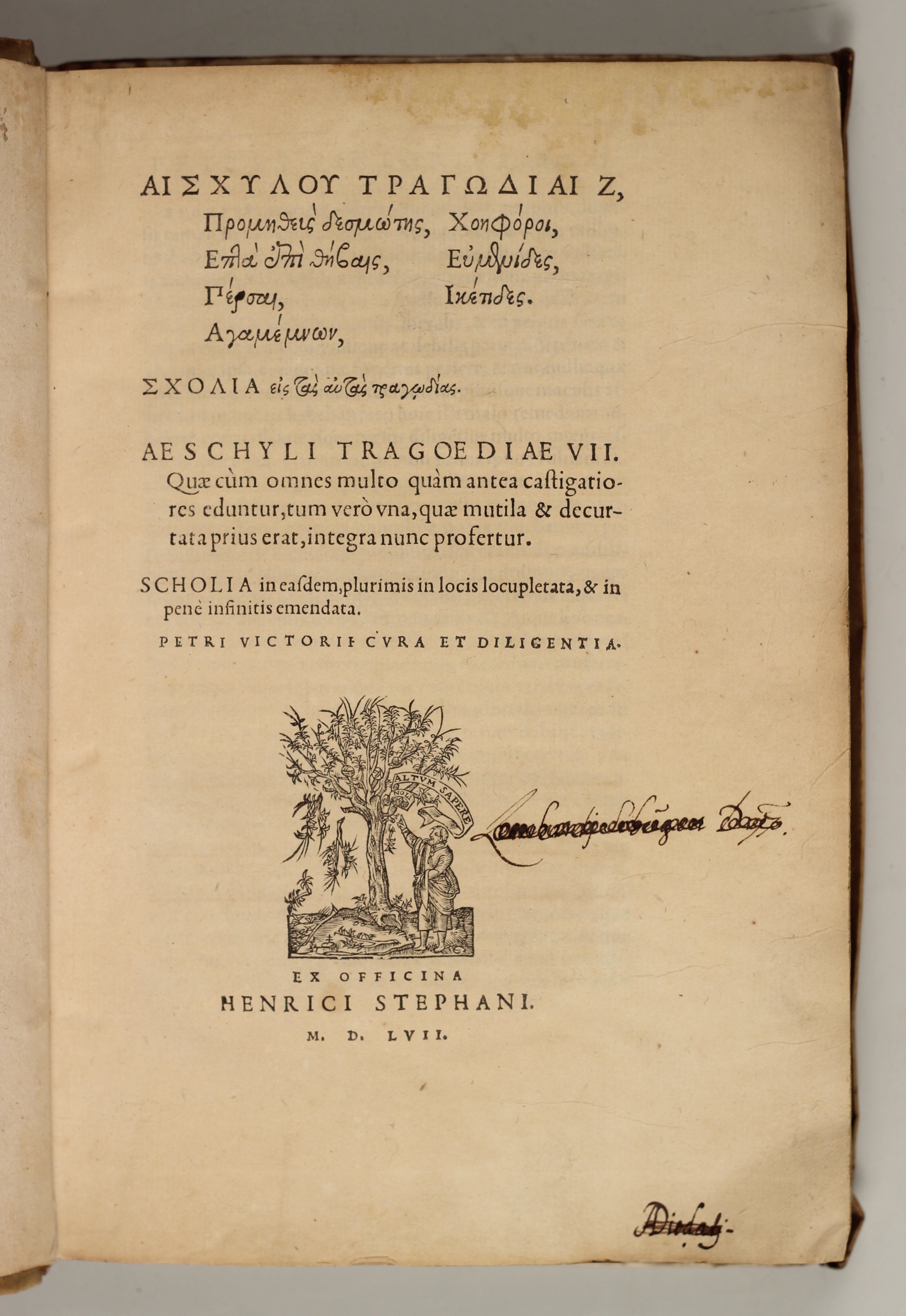Aischylos / Ed. Piero Vettori
Τραγῴδιαι Ζ … — Geneva 1557 [sold]
Τραγῴδιαι Ζ … Σχόλια εἰς τὰς αὺτὰς τραγῳδίας … Petri Victorii cura et diligentia. — Ex officina Henrici Stephani. M. D. LVII.
[Geneva, Henri Estienne, 1557].
4to (245 x 163 mm). a-f4 g-z A,B8 C-I4 (i4 blank): (4) leaves, 395 pp. (with 2 unnumbered pages (leaf N2) between pp. 138 and 139), (1) blank leaf.
Different early verse numbering in red (every 5 verses) and brown ink (every 50 verses). A few annotations in red ink in Estienne’s Observationes. Some underlinings in red. Two names on title scribbled out. Modern ex-libris to paste-down. Watermargin to the first two leaves (see photo of title-page). Light toning. Contemporary vellum with yapp edges. Copy with wide margins.
Fred Schreiber, The Estiennes, 145:
„First complete edition of Aeschylus, including the editio princeps of the Agamemnon, the greatest Aeschylan tragedy, and one of the greatest masterpieces of Western dramatic literature.
The three previous editions (Venice [Asulanus] 1518, Venice [Robortellus] 1552, Paris [Turnebe] 1552) had all been based on a manuscript tradition exhibiting a lacuna of more than two-third of the Agamemnon, owing to the loss of 14 leaves in the famous 11th-century Medicean codex, from which this tradition derives. Piero Vettori (Petrus Victorius, 1499-1585) restored the 1275 missing verses of the Agamemnon from the 14th-century Laurentian codex F, which also allowed him to give an improved text of the Scholia. Vettori, for the first time, carefully distinguishes the Agamemnon from the next play, the Coephori, unlike all previous editors, who had combined the two plays into one tragedy.
Henri Estienne (whom Vettori in his preface calls „eruditus ac diligens iuvenis“) further corrected Vettori’s text, and contributed 40 pages of very important textual comments (cf. E. Fraenkel, Aeschylus, Agamemnon [Oxford 1950], I, p. 34).
The book is handsomely printed in two sizes of „grecs du roi“ (middle size for text, smallest size for scholia), a duplicate set of which Robert Estienne hat taken with him to Genova (see Armstrong, p. 222).“
I may add that the discovery of Agamemnon and Coephori beeing to two different tragedies was made by Francesco Robortello.
Renouard 166 no. 15; Adams A-266; Hoffmann I 34. For details see J. A. Gruys, The early printed editions (1518-1664) of Aeschylos … Nieuwkoop 1981, pp 77-96.
Αισχυλος Aeschylus Aeschylos Aischylus Aischylos Eschyle Eschilo アイスキュロス









